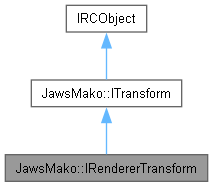A simple transform that scans and sanitises CFF Fonts for wider interoperability. More...
#include <transforms.h>

Static Public Member Functions | |
| static JAWSMAKO_API ICFFSanitizerTransformPtr | create (const IJawsMakoPtr &jawsMako, const IAbortPtr &abort=IAbortPtr()) |
| Create the transform. | |
Additional Inherited Members | |
 Public Member Functions inherited from JawsMako::ITransform Public Member Functions inherited from JawsMako::ITransform | |
| virtual IDOMBrushPtr | transform (const IDOMBrushPtr &brush, eBrushUsage usage=eBUGeneral, const CTransformState &state=CTransformState())=0 |
| Apply the transform to the given brush, if applicable. These transforms are thread safe. | |
| virtual IDOMImagePtr | transform (const IDOMImagePtr &image, const CTransformState &state=CTransformState())=0 |
| Apply the transform to the given image, if applicable. These transforms are thread safe. | |
| virtual IDOMColorPtr | transform (const IDOMColorPtr &color, const CTransformState &state=CTransformState())=0 |
| Apply the transform to the given color, if applicable. These transforms are thread safe. | |
| virtual IDOMColorSpacePtr | transform (const IDOMColorSpacePtr &colorSpace, const CTransformState &state=CTransformState())=0 |
| Apply the transform to the given colorspace, if applicable. These transforms are thread safe. | |
| virtual IDOMNodePtr | transform (const IDOMNodePtr &node, bool &changed, bool transformChildren=true, const CTransformState &state=CTransformState())=0 |
| Apply the transform to the given node, if applicable. These transforms are thread safe, providing no other transforms are being applied to the same nodes at the same time. | |
| virtual void | transformPage (const IPagePtr &page, bool transformContent=true, bool transformAnnotations=true)=0 |
| Apply the transform to the given page, if applicable. These transforms are thread safe, providing no other transforms are being applied to the same nodes at the same time. The transform will also apply to the annotations appearances. | |
| virtual void | flushCaches ()=0 |
| Flush the caches used by the transform. Most transforms cache recently transformed results to improve the performance of repeated transformations of equivalent results. However, it is possible that some cached results may point to entities that no longer exist, such as content inside an XPS file that no longer exists. If you are deleting or replacing files where transforms have been used, it is advisable to invoke this routine to clear the caches. | |
| virtual void | setProgressMonitor (const IProgressMonitorPtr &progressMonitor)=0 |
| Set the IProgressMonitor object for this transform to allow for monitoring the progress of the transform. | |
 Public Member Functions inherited from IRCObject Public Member Functions inherited from IRCObject | |
| virtual void | addRef () const =0 |
| Increases the reference count of the actual object pointed to. This would take place during an assignment or copying. | |
| virtual bool | decRef () const =0 |
| Decreases the reference count of the actual object pointed to. When the reference count falls to Zero, it deletes the actual object pointed to. | |
| virtual int32 | getRefCount () const =0 |
| Retrieve the current reference count of the actual object pointed to. | |
 Protected Member Functions inherited from IRCObject Protected Member Functions inherited from IRCObject | |
| virtual | ~IRCObject () |
| Virtual destructor. | |
A simple transform that scans and sanitises CFF Fonts for wider interoperability.
Some consumers and operating systems may have problems with certain CFF font structures, which this transform seeks to normalise.
Useful for cases where a CFF based OpenType font may need to be used with unknown downstream viewiers in XPS, SVG, etc.
|
static |
Create the transform.
| jawsMako | The JawsMako instance. |
| abort | An abort callback handler. |